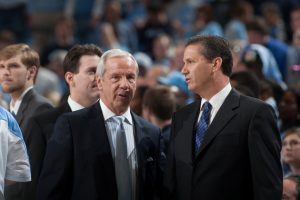Last Saturday night, I found myself sitting in the concrete husk of an arena called RFK Stadium. I was there to watch DC United take on the New York Red Bulls. Mostly, I went because I enjoy a good game of soccer… and the ticket was free. By luck of the schedule, this meant I would have the chance to watch one of the legends of the game, Thierry Henry. Henry enjoyed a stretch with Arsenal in the early 2000s when he was the premier striker in the world. He lead “The Invincibles”, the Arsenal team that won the 2003-2004 title without losing a league game all season long. No one could touch the Gunners, and no defense could stop Henry. His speed, touch and creativity terrified and inevitably overcame all opposition. To compare a player to Henry is one of the highest compliments one can give to a forward.
The divide between Henry and his current teammates was enormous. Not so much athletically, for he no longer can terrify defenses with speed. But in the classic manner of the aging superstar, he can still see how he would like to play the game, if only his body would allow him to do so.
In the first half, Henry looked frustrated. DC picked up an early goal, and the Red Bulls struggled to mount any sustained possession. Henry faded in and out of the game, engaging in a few, scattered moments of dangerous play. Mostly he just drifted. After attempting a backheeled through ball to a teammate along the near sideline, Henry threw up his hands in disbelief when the winger failed to make the necessary run to receive the weighted pass. But he was not just a negative figure on the field. Every positive effort, each threatening through ball or shot fired just wide, received a nod and a thumbs-up from Henry. The other players did not look to the sidelines for affirmation, they looked to their legendary striker. Henry, for his part, walked around the field like a team president who just happened to be wearing cleats.
Eventually New York fell into a rhythm, and for most of the game they dominated play. The ball rarely left their offensive half and all of the dangerous chances were in their favor. Despite this, they could not tie the game, and it ended as a 1-0 DC United victory. It didn’t matter. This was a chance to see one of the greatest to ever play the game jog around a sparsely-attended, converted football and baseball stadium. It was a chance to see a Premier League and World Cup hero, even if the setting did not match the player. And most of all, it was a reminder of how far the MLS has come as a league, and a sign of how much further it has to go.
A decade ago, an MLS game at a stadium like RFK would have been normal. But the league has advanced to the point where, for almost every team, playing in cavernous stadium on a field with faded football lines is not good enough. Every team but three, DC, the Seattle Sounders and the New England Revolution, now plays in or is building a soccer-specific stadium. The Sounders share their stadium with the Seahawks, but they have by far the highest average attendance in the league, so they really cannot be criticized.
DC United is hoping to build a stadium of its own so that it can move out of the less-than-ideal RFK. It is hard for a crowd to generate much energy when the fans are scattered around a stadium built for four times their number. On one side, the DC United supporters group occupied two sections and admirably stood and sang and generally made noise throughout the game. But there were not enough of them, and on the side of the stadium where I sat the majority of the noise came in the form of shrieks from a collection of local youth soccer teams. The diehards sit too far apart from each other to affect the game in the way a home crowd should. A concentrated group of 9-year olds, or even 20 or so Red Bulls fans, can drown others out simply because they are sitting together. RFK can hold almost 46,000 fans, and this year DC United has drawn an average of 11,543.
If those fans had a stadium like the Philadelphia Union’s 18,000 seat PPL Park, then they would not be silenced by empty seats. This would lead to a more energetic environment which would benefit both the players on the field and the fans in the stands. As I sat in the largely silent stadium, through a first half of uninspired play, I found myself almost asleep. Yes, the game itself was nothing special, but an engaged crowd could have made up for that. Smaller stadiums magnify the effects of crowds, and this in turn leads more people to go to games. What every MLS team except DC and New England has realized is that it is much better to fill a small stadium than to fill a few sections in a giant one.
Henry and RFK are at about the same stages of their careers. They command some respect because of what they once were, but their current limitations are obvious. The difference between the two lies in that one represents a direction the MLS is trying to move toward, while the other is a symbol of an era the league hopes to leave behind. If the league wants to exist in part as a sort of retirement home for European greats, and it seems that every week another player such as Carlos Puyol, Xabi Alonso or even Zlatan Ibrahimovic is answering questions on a future MLS move, then it must be able to provide a decent game environment to attract those stars. The concrete behemoths of the past must remain there, and New England and DC should catch up with the rest of the MLS. No one expects to find the Bernabeu or Old Trafford in downtown DC, but teams like Los Angeles have shown that MLS teams can have loud, loyal fan bases. The interest for soccer is growing in America, but for it to reach its potential, a neutral fan should be able to go to a game and not be put to sleep by the atmosphere.
Photo: Ben Schumin





